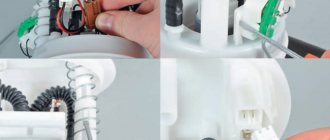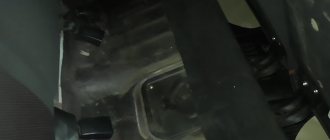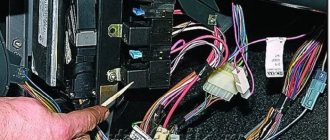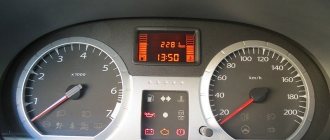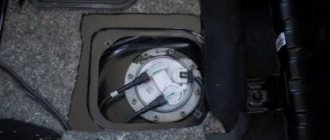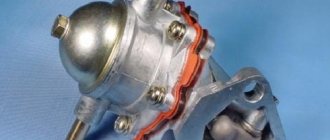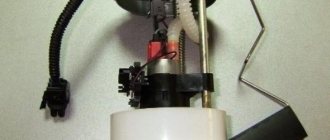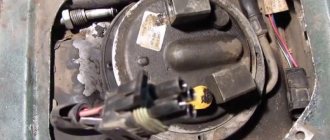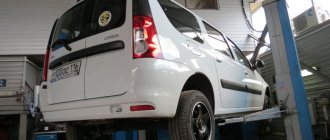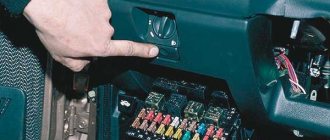We disassemble the module in order to change the filter
The main thing to keep in mind: first disconnect the brown connector.
Then remove the level sensor by unfastening the clamp with a screwdriver. Disassembling the pump module
Similar clamps also hold the top cover. Having removed it, disconnect the snow-white connector (see photo). How to remove the lower part of the module is discussed in the previous chapter. But you will have to tinker with the pipes: when putting them on or removing them, the fittings need to be held above the steam.
The most difficult operation
No one was able to achieve results right away.
What is the best way to deal with a test tube?
On the Lada Largus, the fuel filter is a test tube containing paper. This tube is not sold separately, and it is not allowed to change it. But it can be cut to remove the filter element one hundred percent.
Fuel filter housing
At the last step, both halves are glued together, and drying is done under pressure (on ties).
So, we have an “empty” filter housing that is installed in the space. After assembling the module, it can be used, but there is a condition: after 1000-2000 km the module will have to be changed. Follow our advice if the engine has “ran” 150-160 thousand and you no longer feel sorry for it.
What should you not create?
It would seem that you can drive for a long time with a cleaned tube, you just need to insert a new filter into the fuel line. This is usually done by taking a filter from Renault Logan (phase 1).
Fitting the filter into the line under the hood
What comes out is this:
- If the test tube is empty and an “external” filter is added, the motor starts and stalls after 2-3 seconds;
- If the test tube has not been cleaned, adding a new filter is useless: the overload on the pump increases, and that’s all.
Let the reader draw his own conclusions.
Another variant
Below is a test tube that looks almost the same as the unique fuel filter of the Lada Largus.
JS Asakashi brand components
This tube can be installed instead of the standard one. You just need to shorten the fastening elements (tubes) by approximately 20 mm. We were talking about filters for Nissan passenger cars:
- JS ASAKASHI FS22001
- JAPANPARTS FC-130S
- PATRON PF3924
Gasoline pump Lada Largus (removal and installation)
VAZ 2110 fuel pump pinout
If engine power drops, increased noise occurs, or noise is periodically heard when the fuel pump is operating, then most likely the fuel pump has failed. Pre-check the pressure in the fuel supply system. If the pressure in the system is less than 3 kgf/cmg, this may be caused by a malfunction of the electric pump, fuel pressure regulator, or clogged filter elements. In some cases, the fuel pump module can be repaired, but to do this it must also be removed from the vehicle. If all indirect signs indicate that the pump is faulty, then it must be removed and replaced. You will find information on how to do this in this article.
Lada Largus fuel pump does not work - the main reasons
1. The first thing to check is the fuel pump itself.
To do this, check whether voltage is coming to the fuel pump block. This can be done simply using a regular lamp or multimeter. If the light comes on, then voltage is going to the block, then you will have to disassemble the fuel station and look at the pump.
Fuel pump fuse Lada Largus
This is another common reason why the Lada Largus fuel pump does not work. The Largas fuel pump fuse is located in the mounting block under the hood.
We open the mounting block and find fuse F3 at 25A. This is exactly what it should be like from the factory. We check the fuse, if it is burned out, replace it with a new one.
Fuel pump relay Lada Largus
A faulty fuel pump relay on the Lada Largus is also a common failure in domestic station wagons.
You can also find the Lada Largus fuel pump relay in the mounting block under the hood marked K4 in the diagram.
Connector Lada Largus fuel pump
Another common breakdown is the Lada Largus fuel pump connector. This is due to poor contacts, which over time can oxidize, heat up and melt the pad. If measures are not taken, the contact will disappear completely, completely cutting off power to the fuel pump. The way out of the situation is to replace the block, which has the article number:
4631148764668 Connector for fuel pump module “LADA Largus”
And if the contacts of the fuel pump module are burnt, you will also have to buy the upper part of the pumping station:
Russia BAPFP11 Fuel pump upper part of housing
Changing the fuel filter on a Lada Largus with your own hands
Electrical diagram for connecting the fuel pump VAZ 2110
The fine fuel filter on Largus station wagons and vans is built into the fuel pump module. According to the regulations, this filter must be changed together with the module, and the period between replacements is 160 thousand km. The Renault company, unlike VAZ, specifies an interval of 120 thousand, but the essence will be the same - replacing the fuel filter on the Lada Largus and Logan is carried out only with a pump. We will look at what can be done to get a completely usable, but still temporary solution. At the same time, it will be indicated how to replace the mesh filter.
If anyone doubts the presence of a “paper” filter, you can look at it from the inside. Here's a video.
Fuel filter part numbers
Let's name the fuel module part numbers here: 8200307403, 6001547605 and 6000591702. Renault also uses part number 172024388R. As for the mesh filter, there is no original article, but there are substitutes:
- MASUMA MPU025N
- NPA NP51109412
Selection of analogues
The fuel module can be produced under the following brands:
- BOSCH 0 986 580 957 or 0 986 580 369
- ERA 775120
- ASAM 30290
- PIERBURG 7.00468.77.0
- MAPCO 22100
- DELPHI FG0993-12B1
- MAGNETI MARELLI 519746909900 or 313011313047
- VALEO 347066
- BRECKNER BK14003
- KRAUF KR0820M
- WEEN 1920001
- VAICO/VEMO V21090001
- LEX HT2544
- TSN 7262
- HOFFER 7506872
- AIRTEX E10367M
- SIDAT 72268
- MESSMER 775120
- MEAT & DORIA 76872
Make a choice.
Part replacement
Changing the fuel filter on the Lada Largus with your own hands
Replacing the fuel filter on a Lada Largus is not so difficult if you know where it is located and how to carry out the repair correctly. It is worth noting that even an amateur car repairman can carry out the replacement procedure, since the whole process is extremely simple. The event does not require any special preparation, except for taking the following measures:
- Place the car in a reasonably spacious and level place, securing it securely (handbrake, wheel stands, etc.);
- prepare a basic car repair kit: a set of keys, a pair of screwdrivers, rags and gloves;
- purchase a fuel pump assembly or a fuel pump “mesh” separately in advance (for example, a similar part from Renault Logan will do).
The replacement procedure itself takes no more than half an hour, of course, if you are not going to completely disassemble the fuel pump and try to clean the filter using “old-fashioned” methods or replace it with a homemade one. Moreover, it is undesirable to do this only because by incorrectly cleaning or assembling the fuel pump, you can provoke more serious damage to the fuel system of your Lada Largus. Is it worth it? Most likely no.
So, the algorithm for replacing the fuel filter is as follows:
- Remove the rear sofa cushion and lift the plastic hatch underneath. For ease of work, you may need to move the carpeting to the side.
- Having first disconnected the battery, bend the tab on the fuel pump connector and disconnect it.
- Next, you need to connect the battery and start the engine. The running engine should run for a few seconds and then stall. After this, de-energize the system again by disconnecting the battery terminals.
- Disconnect the fuel pipe and unscrew the fuel pump retaining ring counterclockwise. Using a mounting spatula will help make this step easier.
- After completing the previous steps, the fuel pump module can be removed. If necessary, replace the mesh filter or the entire fuel pump. After replacement, it is necessary to reassemble the entire structure in reverse order.
Important! It is not advisable to disassemble the fuel pump to replace the filter. This practice may negatively affect the condition of the entire fuel system in the future. It’s better not to skimp and replace the entire fuel pump
It’s better not to skimp and replace the entire fuel pump.
As you can see, replacing the Lada Largus fuel filter is quite simple if you know its design features and location in the car. We hope the material presented above was useful to you. Good luck on the roads and in repairs!
Replacing the fuel filter Lada Largus - video:
- Largus oil filter
- Cabin filter Lada-Largus
- Reviews for Aswa CV joints
- Lada Priora trunk malfunctions
Operations for removing the fuel pump Lada Largus
1. Reduce the pressure in the supply system. 2. Disconnect the wire from the negative terminal of the battery. 3. Remove the second row seat cushion. 4. Unscrew the two plastic nuts securing the air duct cover.
5. . remove the nuts.
6. and air duct cover
7. Unscrew the two plastic nuts securing the floor covering on the left and right.
8. Remove the lower edges of the left and right rear door seals from the sill flanges.
9. . and raise the floor covering in the rear seat area.
10. Use a special plastic mounting spudger or a flat-blade screwdriver to pry off the fuel module hatch cover.
eleven. . remove the cover and move it to the side.
12. Press the clamp of the wiring harness block.
13. . and disconnect the block from the fuel module connector.
14. Squeeze the fuel line tip mounting bracket.
15. . and disconnect the fuel line from the fuel module fitting.
16. Unscrew with a special key and remove the pressure ring of the fuel module. If you do not have a special wrench, use a hammer to lightly tap it tangentially through a drift to loosen the pressure ring of the fuel module and unscrew it by hand.
17. Remove the fuel module from the fuel tank and drain the fuel from it into a previously prepared container.
18. Remove the O-ring.
When installing, replace the O-ring with a new one.
19. Install the fuel module in the reverse order of removal.
Make sure that when you reinstall the fuel pump module into place, the marks on it and on the body match. (labels A and B)
How to remove the fuel module on Lada XRAY and Largus
Lada Largus and XRAY cars are equipped with the same type of electric fuel pump module (MEBP) from Renault, article number 17202 2047R. Removing the fuel module on these machines is performed in a similar way, but there are a number of features. Let's look at this process in detail for each model.
Required
: 10mm wrench, hammer, flat screwdriver.
For Lada Largus:
- Raise the second row seat cushion.
- Remove the air duct cover by unscrewing the two plastic nuts.
- Raise the floor covering by first unscrewing the plastic nuts securing it on the left and right, and also removing the sill flanges on both sides.
Operations for removing the fuel pump Lada Largus
1. Reduce the pressure in the supply system. 2. Disconnect the wire from the negative terminal of the battery. 3. Remove the second row seat cushion. 4. Unscrew the two plastic nuts securing the air duct cover.
5. . remove the nuts.
6. and air duct cover
7. Unscrew the two plastic nuts securing the floor covering on the left and right.
8. Remove the lower edges of the left and right rear door seals from the sill flanges.
9. . and raise the floor covering in the rear seat area.
10. Use a special plastic mounting spudger or a flat-blade screwdriver to pry off the fuel module hatch cover.
eleven. . remove the cover and move it to the side.
12. Press the clamp of the wiring harness block.
13. . and disconnect the block from the fuel module connector.
14. Squeeze the fuel line tip mounting bracket.
15. . and disconnect the fuel line from the fuel module fitting.
16. Unscrew with a special key and remove the pressure ring of the fuel module. If you do not have a special wrench, use a hammer to lightly tap it tangentially through a drift to loosen the pressure ring of the fuel module and unscrew it by hand.
17. Remove the fuel module from the fuel tank and drain the fuel from it into a previously prepared container.
18. Remove the O-ring.
When installing, replace the O-ring with a new one.
19. Install the fuel module in the reverse order of removal.
Make sure that when you reinstall the fuel pump module into place, the marks on it and on the body match. (labels A and B)
We disassemble the module in order to replace the filter
The main thing to remember: first disconnect the brown connector. Then remove the level sensor by unfastening the clamp with a screwdriver.
Disassembling the pump module
Similar clamps hold the top cover. Having removed it, disconnect the white connector (see photo). How to remove the lower part of the module is discussed in the previous chapter. But you will have to tinker with the nozzles: when putting them on or removing them, the fittings must be held above the steam.
The most difficult operation
No one was able to achieve results right away.
What is the best way to deal with the flask?
On the Lada Largus, the fuel filter is a flask containing paper. This flask is not sold separately and cannot be replaced. But it can be cut to remove the filter element completely.
Fuel filter housing
At the last step, both halves are glued together, and drying is done under pressure (on ties).
So, we have an “empty” filter housing that is being installed in place. After assembling the module, it can be used, but there is a condition: after 1000-2000 km the module will have to be replaced. Follow our advice if the engine has run for 150-160 thousand and you don’t feel sorry for it anymore.
What not to do!
It would seem that you can drive for a long time with a cleaned bulb, you just need to insert a new filter into the fuel line. This is usually done by taking a filter from Renault Logan (phase 1).
Fitting the filter into the line under the hood
It turns out this:
- If the flask is empty and an “external” filter is added, the engine starts and stalls after 2-3 seconds;
- If the flask has not been cleaned, adding a new filter is useless: the load on the pump increases, and that’s all.
Let the reader draw his own conclusions.
Alternative option
Below is a flask that looks almost the same as the original Lada Largus fuel filter.
JS Asakashi brand components
This flask can be installed instead of the standard one. You just need to shorten the fastening elements (tubes) by about 20 mm. We were talking about filters for Nissan cars:
- JS ASAKASHI FS22001
- JAPANPARTS FC-130S
- PATRON PF3924
Changing the fuel filter on a Lada Largus with your own hands
The fine fuel filter on Largus station wagons and vans is built into the fuel pump module. According to the regulations, this filter must be changed together with the module, and the period between replacements is 160 thousand km. The Renault company, unlike VAZ, specifies an interval of 120 thousand, but the essence will be the same - replacing the fuel filter on the Lada Largus and Logan is carried out only with a pump. We will look at what can be done to get a completely usable, but still temporary solution. At the same time, it will be indicated how to replace the mesh filter.
If anyone doubts the presence of a “paper” filter, you can look at it from the inside. Here's a video.
The need to replace the air filter on Largus
It has long been undeniable that the air filter in the air duct plays a significant role, because along with its fuel “colleague” it ensures the purity of the mixture sent to the combustion chambers. The power characteristics of the LADA Largus engine directly depend on this factor. Operating a car involves no alternative and gradual clogging of the component we are considering. You should not wait until the filtering function completely stops, because the operation of the motor will be impossible, and the harm to it cannot be overestimated. A Lada Largus with a dirty air filter will be prone to increased fuel consumption and an unjustified reduction in power. The manufacturer deliberately placed the air filter in the most convenient location. So that the owner is not lazy to look into it and assess the degree of clogging. If the fact of contamination is obvious, then resort to replacement as soon as possible. This work will be feasible even for an owner who has just embarked on the path of a car enthusiast.
161Akb-Pomosh › Blog › Replacing the fuel pump Largus Van
Initially, the car did not keep idle speed when “cold”; the only thing that helped was to keep the engine at low speed until it warmed up. Since the Largus was being painted, this did not bother me much, until it stopped starting altogether - the starter turned, but to no avail. In this case, I wouldn’t have to rack my brains and go for diagnostics, but I couldn’t drive under my own power, and I didn’t really want to drag it on a cable. As a result, after studying the mat. parts on the Internet)) was done: 1. All relays and fuses have been checked.2. The throttle was cleaned and the small o-ring was replaced (it already had a square shape and microcracks. I didn’t change the big one, it looked in good condition).3. Cleaned the DPKV, measured the resistance - 243. It seems to be normal for the K4M engine. It was very difficult to get it; personally, it took me an hour of time and a little swearing)).4
I paid attention to the immobilizer operation indicator - it stopped blinking if you inserted the key into the ignition. An experienced technician would say. What about the fuel pump? Can I check it? But I didn’t want to believe that at 104,000 km it died - I didn’t want to, because before that on other cars of different brands I ran 150 t.km. In short, after listening to whether the pump worked before starting the engine, I decided to remove the fuel module from the gas tank
I won’t post photos of the whole process, there’s a lot on the internet, but I couldn’t find how to get it out of the van. Maybe it will be useful to someone.1. Remove the negative terminal from the battery.2. Remove the rubber carpet in the cargo compartment, if there is one.3. The floor of the cargo compartment is divided into three parts; unscrew the part that is closer to the right cargo door. You will need a Torx key, I don’t remember how much, take a set because you will need 2 sizes.4. Part of the floor goes under the plastic bulkhead - so as not to unscrew it, I simply lifted it up and secured it to the ceiling with a rope.
5. I had a LOT of dust in the well of the fuel module (3 centimeters), so it is advisable to vacuum it or blow it with air so that it does not get into the tank. I took a photo of the fuel pipe that fits onto the Module; the inside is terribly dirty.
6. Then everything is standard - I took out the module, pulled out the fuel pump (I threw plus and minus on the battery and fuel pump terminals - it doesn’t work, so it needs to be changed). I bought a pump from a VAZ 2110 in a nearby store, along with a cleaning mesh - 550 rubles. I read that there was still a need to change some kind of module for fine cleaning - I didn’t bother, in the future there are plans to convert the car to gas.
Removal and repair of the Lada Largus electric fuel pump module
We remove the fuel pump module if the electric fuel pump fails completely or partially, the fuel pump filter is clogged, or the fuel gauge sensor is faulty.
Preparation for module removal largely depends on the car model.
To remove the module, we prepare the car for work.
It is advisable to remove the module so that the amount of fuel in the tank is less than half the tank.
1. If the car is a station wagon, then we tilt the rear row of seats forward for a five-seater configuration and the middle row for a seven-seater configuration.
2. Disconnect and lift the floor covering
If the car has a van body, then remove the trim from the middle pillar, on the right side.
Remove the right side of the body partition.
Remove the right front part of the cargo compartment floor.
3. Remove the plastic cover of the fuel tank hatch
4. Using a flat-head screwdriver, press out the clamp of the wiring harness block
5. Disconnect the block
6. Start the engine to relieve pressure in the fuel system and wait until it stalls.
After this, turn off the ignition and remove the negative terminal of the battery.
Squeeze the fuel pipe tip clamps and remove the tip from the fuel module fitting.
7. Unscrew the union, plastic nut using a mounting spatula
8. If the nut does not budge, you need to make a device from a rod and use this device to unscrew the union nut
9. Remove the union nut
10. Place a rag around the hole to prevent any remaining fuel from spilling onto the car parts.
Carefully remove the fuel module from the tank, removing the float of the level sensor.
Pour the remaining fuel from the module into a container prepared in advance.
11. Remove the rubber o-ring.
12. Disconnect the level sensor wire block.
13. Bend the level sensor clamp.
14. Remove the fuel level sensor.
15. Use a flat screwdriver to release the three glass latches, while prying up the glass
Removing and disassembling the fuel module
We remove the fuel module if any of its elements fail. We show replacement of the fuel pump, strainer or fuel level indicator sensor for the possibility of repairs in road conditions and in the absence of original spare parts.
In the car interior, we raise the seat cushion of the second row.
We lift the plastic cover and remove the carpet from the hatch.
We take out the fuel tank flap and move it to the side.
Use a slotted screwdriver to press out the lock...
...and disconnect the wiring block from the fuel module cover. Next, you should relieve the pressure in the power system. To do this, we start the engine. After working for a few seconds, it will stop due to lack of fuel. The pressure in the system will be relieved. Turn off the ignition.
Squeeze the clamps of the fuel pipe tip and remove it from the fitting of the fuel module cover. The fuel module is fixed in the tank with a clamping ring screwed onto the neck of the tank. The easiest way to unscrew the module's clamping ring is to use a mounting spudger.
Resting against the depressions of the hole made in the body floor panel, use a mounting spatula to push the ring by its protrusions counterclockwise. The procedure may have to be repeated several times, resting on different protrusions around the circumference of the ring. And when assembling, when wrapping the ring, this must be done.
Remove the pressure ring. With the tank removed, a simple device bent from a metal rod in the form of a bracket will help you unscrew the clamping ring.
Device for unscrewing the clamping ring
We remove the fuel module from the tank by removing the float of the fuel level indicator sensor from the hole in the fuel tank.
We take out the rubber o-ring of the fuel module. We drain the remaining fuel from the fuel module into a previously prepared container. We close the hole in the fuel tank with thick paper or polyethylene. Further disassembly of the fuel module is not provided. The car's developers expect to replace the entire module if any of its components fail. However, in extreme circumstances, you can clean the fuel pump inlet strainer, replace the fuel gauge sensor or replace the fuel pump.
Disconnect the fuel gauge sensor wire block from the connector on the inside of the fuel module cover.
Release the fuel level indicator sensor lock.
Remove the fuel level indicator sensor.
Use a screwdriver to release the three cup latches...
...and remove the glass from the filter housing.
The connection of the fuel pressure regulator channel is sealed with a rubber ring.
The cup contains a fuel pressure regulator 1 and an anti-drainage valve 2.
By pulling, remove the strainer from the fuel pump. Now it can be washed or replaced.
Using a screwdriver, press out the lock of the fuel module cover...
...and remove the lid.
Remove the spring from the guide.
Disconnect the fuel pump wire block from the connector on the inside of the fuel module cover.
We remove the fuel pump from its socket in the fuel filter housing. Heating the plastic corrugated tube on the pump nozzle with a stream of boiling water from a kettle...
...remove the tube from the pump connection. We assemble and install the fuel module in the reverse order.
Before installing the module, check that the sealing ring is positioned correctly on the flange of the tank neck. Carefully, so as not to move the o-ring, install the module into the tank.
When installing, we orient the fuel module so that arrow 2 on its cover is located opposite arrow 1 on the tank. Pressing down on the module cover, screw the pressure ring onto the tank neck until the module cover is pressed tightly against the neck. Then we turn the pressure ring to the position at which arrow 3 on the ring is located opposite arrows 1 and 2. We put the tip of the fuel tube onto the fitting of the module cover until the spring clamps of the tip click. After installing the module, turn on the ignition and check the tightness of the connections. When installing the fuel tank flap cover let's orient it like this...
...so that arrow 1 on the cover is located opposite groove 2 made in the body floor panel.
Removing the fuel module
We will perform all the steps as if we were trying to replace a fuel pump:
- We tilt the sofa cushion and remove it. We lift the plastic hatch and move the carpet forward. Remove the round cover from the hole;
Getting rid of unnecessary details
Understanding electricity
First - the pipe, then - the clamp
By removing the module assembly, you can replace the mesh filter. Be careful not to lose the O-ring installed between the module and the tank.
Replacing the filter mesh
On the Lada Largus, the coarse fuel filter is a removable mesh in front of the pump. Replacing it will be simple:
- We snap off the glass latches (3 pcs.);
Let's start disassembling the module
The very first element in the fuel tract
Installation of all modules and components is carried out in the reverse order. If the mesh is not badly damaged, it can only be washed and dried. Car chemicals based on xylene or ethoxylated alcohols will help.
Design of the fuel filter flask in the pump
What is outlined in the figure is the fine filter. Through mesh 2, fuel enters the pump, then it enters container 3. This container is connected to the ramp through the upper fitting and pipe. Connection 1 is also an important element, since it is connected to the return valve.
Fuel module disassembled
The return flow valve is built into the lower glass, and it allows you to relieve excess pressure.
By the appearance of part 3, you can always assess the degree of filter clogging. It's a pity that the container is non-separable. Unfortunately, it is pointless to look for the article number for part 3: the fuel filter on the Lada Largus is replaced as an assembly with the pump.
Replacing the fuel filter
- We fold back the stern seat cushion and open the hatch cover.
- Turn off the pump power fuse.
- We start the LADA Largus engine and give it the opportunity to exhaust the fuel present under pressure in the circuit. The unit will stall.
- Turn off the power by removing the terminals from the battery.
- Disconnect the fuel lines leading to the pump module.
- Unscrews the locking disc.
- Having freed the pump assembly inside the mounting socket, we remove it and replace it with a new analogue. If you only need to replace the mesh filter, perform this action.
- After assembling the structure using the reverse algorithm, we must check the tightness of the system.
When to change
You will not be able to know if the fuel filter is dirty unless you regularly check its integrity and condition. Due to the specific design, the fuel cell on Largus is endowed with a “heroic resource”. As AvtoVAZ says, fuel filters together with the fuel pump are designed for the entire period of operation of the car, that is, about 160 thousand kilometers. But is this true? Based on practical experience, no.
Considering the average statistics, we can highlight the following:
- a mesh filter in the nozzle of the injection system, which passes fuel through itself after primary and fine cleaning, can last no more than 30-45 thousand kilometers;
- The main fuel filter has a service life of 80-120 thousand kilometers.
Experienced car repairmen advise every Largus owner to dismantle the entire fuel pump module and check the level of filter contamination every 20 thousand kilometers. The check is also carried out if:
- slight loss of traction;
- problems with the fuel system;
- reduction or increase in fuel consumption.
The main difference between the fact that it is the fuel filter element that is dirty is the gradual appearance of the symptoms described above.
Removing the fuel module
We will perform all the steps as if we were trying to replace a fuel pump:
- We tilt the sofa cushion and remove it. We lift the plastic hatch and move the carpet forward. Remove the round cover from the hole;
Getting rid of unnecessary details
Understanding electricity
First - the pipe, then - the clamp
By removing the module assembly, you can replace the mesh filter. Be careful not to lose the O-ring installed between the module and the tank.
Replacing the filter mesh
On the Lada Largus, the coarse fuel filter is a removable mesh in front of the pump. Replacing it will be simple:
- We snap off the glass latches (3 pcs.);
Let's start disassembling the module
The very first element in the fuel tract
Installation of all modules and components is carried out in the reverse order. If the mesh is not badly damaged, it can only be washed and dried. Car chemicals based on xylene or ethoxylated alcohols will help.
Fuel pump Lada Largus 16 valves article number and 8 valves
The Lada Largus fuel pump for a 16-valve engine comes under the article number 172024388R.
8-valve engines and 16 valves have the same fuel pump and are no different. It would be more correct to say that this is not the fuel pump itself, but the fuel station assembly. The manufacturer intends to completely replace the entire fuel station without any repairs.
However, this does not mean that a new electric element of the fuel pump cannot be purchased and replaced. Here are some items for ordering the Lada Largus fuel pump itself:
BM FP0007 Kraft KT800080 Gallant GL.FP.1.2
Replacing the fuel pump on Largus
Traditionally, two fuel filters are installed on Lada cars to purify gasoline. One of them is called a coarse filter (mesh) and is located in the fuel pump, and the other fine filter is in the form of a separate module (replaced after 10-20 thousand km), which is attached to the bottom of the car near the gas tank. Let's look at how to replace the Lada Largus fuel filter.
If you open the “do-it-yourself repair manual for Lada Largus”, then in the “power system” section you will not find the usual instructions for replacing the fuel filter. The fact is that both filters (coarse and fine) are built into the fuel module (gasoline pump). If it is not difficult to clean or change the fuel pump mesh, then replacing the Lada Largus fine fuel filter will not work; it is only replaced as an assembly with the fuel pump after 120 thousand km. mileage
- fuel pump mesh (articles: FRANCECAR FCR210141, MASUMA MPU025N, NPA NP51109412)
- fine filter (JS ASAKASHI FS22001, JAPANPARTS FC-130S, PATRON PF3924)
To remove the Lada Largus fuel pump, you will need to disconnect the negative terminal of the battery, and then remove the floor covering in the rear seat area by unscrewing several screws. Remove the plastic cover by prying it off with a flat-head screwdriver. Disconnect the connectors and fuel line from the fuel module and remove it by unscrewing it with a special key.
By disconnecting the lower part of the fuel pump, you can gain access to the coarse mesh. It is replaced with a new one, or cleaned and installed in the reverse order.
It is not possible to replace the fine fuel filter; you can only cut its housing, first removing the fuel pump:
Let us remind you that the Lada Largus has other design features, for example, this model does not have a cabin filter.
The fine fuel filter (housing), the coarse filter (mesh), the fuel pump, and the fuel level sensor are located in the fuel module complex, which is located in the fuel tank.
Note: According to the regulations, replacement of individual parts of the fuel module is not provided, and in the event of failure of any of its components, the module is replaced as an assembly. However, in an emergency, to replace the fuel pump, clean the fuel filter, or replace the fuel level sensor, the module can be disassembled.
To disassemble the fuel module and replace parts, remove it from the vehicle. (see here)
Disconnect the fuel level sensor wire block from the cover
Remove the fuel level sensor by sliding it in the direction of the arrow
Fuel level sensor 1 – resistor; 2 – slider; 3 – sensor wire block; 4 – float; 5 – float lever
Using a screwdriver, press out the three plastic clips...
...and remove the glass from the fuel module body. Here is a fine fuel filter (housing) and a coarse mesh filter
Lada Largus fuel pump where is it located?
The standard fuel pump for the Lada Largus is located in the usual place for everyone - in the fuel tank under the rear passenger seat.
It is enough to lift the rear seat and peel back the carpet and you will immediately see the inspection hatch of the fuel pump, through which repairs and maintenance of this unit take place. We already talked about this when we talked about replacing the fuel filter on the Lada Largus.
We disassemble the module in order to replace the filter
The main thing to remember: first disconnect the brown connector. Then remove the level sensor by unfastening the clamp with a screwdriver.
Disassembling the pump module
Similar clamps hold the top cover. Having removed it, disconnect the white connector (see photo). How to remove the lower part of the module is discussed in the previous chapter. But you will have to tinker with the nozzles: when putting them on or removing them, the fittings must be held above the steam.
The most difficult operation
No one was able to achieve results right away.
What is the best way to deal with the flask?
On the Lada Largus, the fuel filter is a flask containing paper. This flask is not sold separately and cannot be replaced. But it can be cut to remove the filter element completely.
Fuel filter housing
At the last step, both halves are glued together, and drying is done under pressure (on ties).
So, we have an “empty” filter housing that is being installed in place. After assembling the module, it can be used, but there is a condition: after 1000-2000 km the module will have to be replaced. Follow our advice if the engine has run for 150-160 thousand and you don’t feel sorry for it anymore.
What not to do!
It would seem that you can drive for a long time with a cleaned bulb, you just need to insert a new filter into the fuel line. This is usually done by taking a filter from Renault Logan (phase 1).
Fitting the filter into the line under the hood
It turns out this:
- If the flask is empty and an “external” filter is added, the engine starts and stalls after 2-3 seconds;
- If the flask has not been cleaned, adding a new filter is useless: the load on the pump increases, and that’s all.
Let the reader draw his own conclusions.
Alternative option
Below is a flask that looks almost the same as the original Lada Largus fuel filter.
JS Asakashi brand components
This flask can be installed instead of the standard one. You just need to shorten the fastening elements (tubes) by about 20 mm. We were talking about filters for Nissan cars:
- JS ASAKASHI FS22001
- JAPANPARTS FC-130S
- PATRON PF3924
Disassembling the module: replacing (cleaning) the fuel filter, fuel pump and fuel level sensor
The fine fuel filter (housing), the coarse filter (mesh), the fuel pump, and the fuel level sensor are located in the fuel module complex, which is located in the fuel tank.
Note: According to the regulations, replacement of individual parts of the fuel module is not provided, and in the event of failure of any of its components, the module is replaced as an assembly. However, in an emergency, to replace the fuel pump, clean the fuel filter, or replace the fuel level sensor, the module can be disassembled.
To disassemble the fuel module and replace parts, remove it from the vehicle. (see here)
Disconnect the fuel level sensor wire block from the cover
Having released the latch...
Remove the fuel level sensor by sliding it in the direction of the arrow
Fuel level sensor 1 – resistor; 2 – slider; 3 – sensor wire block; 4 – float; 5 – float lever
Using a screwdriver, press out the three plastic clips...
...and remove the glass from the fuel module body. Here is a fine fuel filter (housing) and a coarse mesh filter
Remove the rubber o-ring of the fuel pressure regulator.
The glass contains a fuel pressure regulator 1 and an anti-drainage valve 2 .
Having overcome the force of the clamps, remove the fuel strainer.
Wash, blow out, or replace the strainer
Note: to replace the fine filter, some car enthusiasts used a non-original filter with art. LF249M (see photos and dimensions)
Using a screwdriver, press the cover latch...
...answer the lid to the side
remove the spacer spring
Disconnect the fuel pump block from the connector on the inside of the cover.
Remove the fuel pump from the fuel filter housing.
Note: Fuel hoses are secured to the fittings of the pump and filter housing by heat shrink.
After heating the plastic corrugated tube on the pump nozzle, remove the tube from the pump nozzle. Use a stream of boiling water from a kettle or a hair dryer for this.
Attention : before using a hair dryer, thoroughly blow and dry the parts to avoid fuel ignition!
Note: After removing the hoses from the fittings, it may be necessary to replace the hoses to ensure a good seal. Some car enthusiasts used corrugated fuel pump hoses for VAZ.
To install and secure the hose on the fuel pump after removal, some car enthusiasts use ordinary clamps (but not the worm type) ~ 11 mm. The clamp must be secured so as to ensure a tight connection and at the same time not crush the plastic hose.
We assemble and install the module in the reverse order.
Some misconceptions about the fuel pump (from Behind the Wheel magazine)
The slightest loss of pump seal will immediately lead to a fire, since its brushes constantly spark.
The gas pump is not a sealed structure, and its internal parts, such as the anchor or brushes, are constantly bathed in gasoline. But combustion is impossible: the concentration of fuel vapors is much higher than the stoichiometric one, and therefore it is impossible to ignite them.
Cars with fuel injection need to be refueled more often, but you can’t drive “with a light bulb” at all.
Many people believe that if the tank is not full, the pump will definitely start sipping air instead of gasoline and quickly die. The pump is placed in a plastic cup that prevents fuel from draining during acceleration and roll. The glass is pressed by a spring to the lowest point of the fuel tank. In addition, internal partitions in the fuel tank prevent the ebb and flow of gasoline. What if the fuel runs out? And there will be no troubles: as soon as the pump stops creating pressure, the engine will stall, and the controller will turn off the power in a couple of seconds.
A motor running “dry” instantly fails.
When the internal combustion engine stalls, power is removed from the electric fuel pump very quickly. Therefore, he does not have the physical ability to thresh for a long time in a “dry” mode. In addition, we ran the pumps “dry” for about ten minutes - and nothing: cold body, low current consumption, even noise. Therefore, the pump will not die from lack of gasoline.
Gasoline plays the role of a lubricant in the electric gasoline pump.
The lubricity of gasoline is negligible. It plays the role of a coolant rather than a lubricant.
Excessive pressure in the fuel line is harmful, so when replacing, it is strictly forbidden to install a more powerful fuel pump.
The bypass valve (pressure regulator) in the fuel module monitors the amount of pressure generated by the fuel pump, sending excess fuel back to the gas tank. Therefore, a more efficient pump will not cause any harm. It’s another matter if you installed a weaker engine than standard: when operating at maximum modes, the engine may not have enough fuel and it will begin to “shut up”.
On cars converted to gas, fuel pumps especially often break down.
There are horror stories on online forums: the gas pump on cars with gas equipment is always running, pushing gasoline in a small circle, and therefore fails more often. But this is a normal mode, no different from a working one. Trouble could arise only if there was a complete lack of gasoline in the tank, but this already resembles sabotage. However, the pumps are also not afraid of short-term dry operation.
Parameters of some gasoline pumps installed on Lada cars (operating modes) (tests of the journal Behind the Wheel)
| Name | Pressure, bar | Current consumption, A | Pressure regulator opening voltage, V | Power consumption when pressed in the line 3.9 bar, W | Capacity l/h | Price/quality ratio, points | |||
| at maximum line pressure | at line pressure 3.9 bar | ||||||||
| at 6.0 V | at 13.5 V | at 6.0 V | at 13.5 V | at 13.5 V | at 13.5 V | at 13.5 V | |||
| 1 Aoton | 2.7 | 7,4 | 3,0 | 7,0 | 5,1 | 8.8 | 68,9 | 111,5 | 4,46 |
| 2 SOATE | 2,3 | 8.2 | 2.4 | 4,3 | 4.3 | 9,8 | 58,1 | 96,6 | 4,65 |
| 3 Bosch | 1,8 | 5,6 | 2,0 | 5,7 | 4,9 | 11,1 | 66,2 | 67,1 | 1 |
| 4 ERA | 2,6 | 6,6 | 2,6 | 7,1 | 4,9 | 8,0 | 66.2 | 127,8 | 5 |
| 5 Cortex | 3.0 | 8,0 | 3,5 | 7,0 | 6,3 | 7.8 | 85.1 | 146,7 | 3,44 |
| 6 Lucas | 2,4 | 4,6 | 2.4 | 6,8 | 5,2 | 9,5 | 70,2 | 92,1 | 2.53 |
| 7 Pekar | 2,0 | 7,2 | 1,0 | 4,6 | 3,3 | 9.8 | 44,6 | 74,7 | 4.84 |
| 8 QML | 2,4 | 7,8 | 2,0 | 7,2 | 5,1 | 9,7 | 68,9 | 118,2 | 4.95 |
Video
Replacing the fuel pump Lada Largus (VAZ Largus)
If engine power decreases, increased noise occurs, or noise is periodically heard when the fuel pump is operating, then most likely the fuel pump has failed. Pre-check the pressure in the fuel supply system. If the pressure in the system is less than 3 kgf/cmg, this may be caused by a malfunction of the electric pump, fuel pressure regulator, or clogged filter elements. In some cases, the fuel pump module can be repaired, but to do this it must also be removed from the vehicle. If all indirect signs indicate that the pump is faulty, then it must be removed and replaced. You will find information on how to do this in this article.
Removing the fuel module
We will perform all the steps as if we were trying to replace a fuel pump:
- We tilt the sofa cushion and remove it. We lift the plastic hatch and move the carpet forward. Remove the round cover from the hole;
Getting rid of unnecessary details
Understanding electricity
First - the pipe, then - the clamp
By removing the module assembly, you can replace the mesh filter. Be careful not to lose the O-ring installed between the module and the tank.
